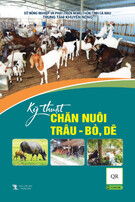
Int.J.Curr.Microbiol.App.Sci (2018) 7(7): 1501-1516
1501
Review Article https://doi.org/10.20546/ijcmas.2018.707.177
Embryonic Mortality in Cattle- A Review
Pinki Rani1, Ravi Dutt1*, Gyan Singh2 and R.K. Chandolia1
1Department of Veterinary Gynaecology and Obstetrics, 2Department of Veterinary Clinical
Complex, Lala Lajpat Rai University of Veterinary and Animal Sciences (LUVAS),
Hisar Haryana 125004, India
*Corresponding author
A B S T R A C T
Introduction
The cattle and buffaloes are known for their
milk production and they contribute
approximately 96% to total milk production in
India. Though milk production in India has
been reached to 132.4 million tonnes in 2012-
13 with a growth rate of 3.5%, but there is
high demand of milk (BAHS, 2014) and it is
projected that by 2030 India will be able to
produce 200 million tonnes of milk (NDRI
Vision, 2030). This target will be achieved if
there is the optimum balance between
conception, embryonic nourishment and
successful calving. Embryo mortality is a
major cause of economic loss in dairy
production systems. An incidence of 20-50%
embryonic and fetal death has been noticed in
apparently normal healthy animals of all
domestic species including bovines (Arthur et
al.,1989) whereas 15% early embryonic
mortality between day 23 and 29 in repeat
breeding Holstein Friesian cows using
ultrasonography and progesterone profile has
been recorded (Patel et al., 2005).According
to a study early and late embryonic death in
Holstein cows in 44 herds in France after first
insemination were 31.6 and 14.7%,
respectively (Humblot, 2001). Late embryonic
deaths after day 27 of gestation ranged from
International Journal of Current Microbiology and Applied Sciences
ISSN: 2319-7706 Volume 7 Number 07 (2018)
Journal homepage: http://www.ijcmas.com
Cattle is one of the major livestock species for milk production, contributing significantly
to the economy of our country and continuous milk production needs regular conception
and successful calf crop production. World-over, for dairy economy, there is emphasis on
one calf per year per cattle. Successful calving follows survival of the conceptus through
embryonic and fetal development. Embryonic mortality is a major source of economic loss
with mortality rate upto 40% in animal production through repeat breeding and increased
cost of artificial insemination, cost of treatment, extended calving intervals and prolonged
dry period resulting in reduced milk production. Factors involved in embryonic mortality
are multifactorial and can be summarized into three intrinsic, extrinsic and embryonic
categories. The present review on embryonic mortality in cattle deals with majority of the
etiological factors.
K e y w o r d s
Artificial
insemination,
Cattle, Embryonic
mortality, Repeat
breeding
Accepted:
10 June 2018
Available Online:
10 July 2018
Article Info

Int.J.Curr.Microbiol.App.Sci (2018) 7(7): 1501-1516
1502
3.2% in dairy cows producing 6000-8000 kg
of milk per year upto 42.7% in high producing
cows under heat stress (Silke et al., 2002). In
dairy cows, rate of pregnancy loss between
day30 and day45 of gestation is 0.85% per day
or approximately 12.8% which is higher than
that observed for beef cows (Beal et al.,
1992). Some studies had reported that highest
incidences of early pregnancy loss occur
during first 56days post-insemination (Fricke
et al., 1998).
Fertilization rate in cattle
Fertilization rate in cattle, in heifers and in
moderate yielding dairy cows, are in the order
of 90-100% following the use of high-quality
semen. In contrast, for higher producing dairy
cows there is less quantitative information on
fertilization rate (Sreenan and Diskin, 1986). It
is observed that embryo resulting from
fertilization of compromised oocyte have a
low probability of successful development
(Hansen, 2002). In a study on the effects of
ambient temperature on fertilization rate it was
reported that fertilization rates are 82.4 and
79.5% for high and low temperatures,
respectively whereas fertilization rate of
55.6% in lactating dairy cows compared with
100% for heifers under high ambient
temperature (Ryan et al., 1993). In a
subsequent study during the winter season,
fertilization rates were 87.8 and 89.5% for
lactating and non-lactating dairy cows,
respectively (Sartori et al., 2002). Based on
milk production, some studies concluded that
fertilization rates of 83 and 88% were
recorded in high-producing dairy cows and it
appears that fertilization rate may be a little
lower in high than in moderate producing
dairy cows, at least during the hot season
(Cerri et al., 2009). Embryonic and fetal
mortality rate in cows with fertilization rate of
90% had an estimated loss of 70-80%
sustained between days 8 and 16 after AI
(Sreenan and Diskin, 1986). The overall loss
rates and the pattern of loss between days 28
and 84 of gestation were similar for cows
producing on average 7247 kg of milk (7.2%)
and heifers (6.1%) and almost half (47.5%) of
the total recorded loss occur between Days 28
and 42 of gestation (Silke et al.,2001).
Another studies also showed similar overall
late embryo or fetal loss rate of 7.5% between
days 30 and 67 of gestation in dairy cows that
were managed under pasture based systems of
production (Horan et al., 2004). The extent of
late embryonic loss is less than early
embryonic loss and causes serious economic
losses, particularly in seasonal calving herds
because it is often too late to rebreed cows,
which results in increased culling rates and
replacement cost (Grimard et al., 2006).
Factors related to embryonic mortality
The main factors implicated in embryonic or
fetal loss are normally categorized as those of
genetic, physiological, endocrine or
environmental origin.
Genetic causes
Genetic causes of embryonic death include
chromosomal defects, individual genes and
genetic interactions (VanRaden and Miller,
2006).Chromosomal aberrations are major
cause of early pregnancy loss in animals
(King, 1990).A range of misalliances can
occur during the pairing of the haploid
parental chromosomal sets at the time of
fertilization, which are subsequently lethal to
the embryo. Chromosomal abnormalities may
also originate by penetration of ovum by more
than one sperm cell (polyspermia).
Mixoploidy, polyploidy and haploidy are all
aberrations that are encountered frequently in-
vitro produced embryos (Viuff et al., 1999)
but it has not been investigated yet whether
this could be a cause for the higher embryonic
mortality rates, which are observed after the
transfer of in-vitro produced bovine embryos

Int.J.Curr.Microbiol.App.Sci (2018) 7(7): 1501-1516
1503
(Van Soom et al., 1994). Chromosomal
abnormalities may account for approximately
20% of the total embryonic and fetal losses
(King, 1990). In the Holstein breed, two major
recessive defects are responsible for embryo
or fetal deaths (Robinson et al., 1984). Also
the DUMPS (Deficiency of Uridine Mono-
Phosphate Synthase) a homozygous recessive
condition, causes fetal death at days 40 to 50
of gestation (Shanks and Robinson, 1989).
Some studies have also reported that, testing
of AI sires for DUMPS reduce the frequency
of heterozygous sires and of homozygous
recessive embryos and has now almost
eliminated this as a cause of infertility
(VanRaden and Miller, 2006). Apart from
these genetic causes, several reproductive
traits are adversely affected by inbreeding.
Maternal inbreeding has been reported to
decrease the 56 to 70day non-return rates by 1
to 2% per 10% inbreeding of the dam (Wall et
al., 2003). Inbreeding of the embryo has been
reported to reduce the 70 days non-return rate
by 1% for each 10% increase in the level of
inbreeding of the embryo. Genetic variation in
embryo survival may be attributable to the
genetic constitution of the embryo itself or the
genetic differences among dams with respect
to their ability to provide an appropriate intra-
ovarian and intra-uterine environment (Cassell
et al., 2003; VanRaden and Miller, 2006).
Another factor is the age of the animal which
is responsible for fluctuations in conception
and embryo survival rate. In heifers,
conception rate is maximum at 15 to 16
months of age and breeding heifers at 26
months of age or older result in a 13%
reduction in conception rate, presumably due
to a lower embryo survival rate (Kuhn et al.,
2006).
Nutritional causes
Following parturition, the nutrient demands of
the dairy cow increase dramatically as peak
lactation yield is approached and typically
exceed dietary intake, resulting in a state of
negative energy balance (NEB). During this
period, body reserves are mobilized to meet
the combined demands of maintenance and
lactation. Reproductive performance decrease
in high producing dairy cows especially when
animals are under severe NE (Nebel and
McGilliard, 1993).Gene expression in uterine
tissue and spleen of cows with severe post-
partum NEB (SNEB) indicate that these cows
have increased expression of many key genes
known to be involved in inflammatory
responses, which is consistent with a re-
modelling of the post-partum uterus and the
clearance of microbial infections. Cows in
SNEB has a delayed immune response and the
pattern of gene expression in the spleen
indicate that this is because immune cells are
exposed to an environment of increased
oxidative stress, causing a reduction in genes
encoding cytokines, which are essential for a
normal immune response cascade (Morris et
al., 2009; Wathes et al., 2009). So, the
importance of maximizing feed intake and
minimizing NEB in the immediate post-
calving period in order to sustain high embryo
survival rates was emphasized (Patton et al.,
2007). Follicles exposed to adverse conditions
such as NEB during their initial stages of
growth seems to impair the development
resulting in the production of inferior quality
oocytes and dysfunctional corpora lutea,
though the hypothesis has not been adequately
tested (Britt, 1994).There is a great
relationship between EB (energy balance),
DMI (dry matter intake) and peripheral
concentrations of insulin-like growth factor-
1(IGF-1) measured during the first 28 days of
lactation and subsequent conception. First
service conception rate is associated positively
with all the three variables because there may
be long term carry-over effects of nutrition
and EB on conception rate, which is an
observation, but effects on fertilization and
types of embryo mortality remain to be
documented (Patton et al., 2007). High

Int.J.Curr.Microbiol.App.Sci (2018) 7(7): 1501-1516
1504
circulating concentrations of insulin have
negative effects on oocyte quality
(Garnsworthy et al., 2008). In some studies, it
has been examined that feeding strategies with
glucogenic-lipogenic substances to dairy cows
have some beneficial effects on reproductive
functions (Garnsworthy et al., 2009; Friggens
et al., 2010). Lipogenic diets increase the
oestradiol secreting capacity of the pre-
ovulatory follicle, provided enhanced
substrate for progesterone production and
improved blastocyst development rates which
reduces embryonic mortality rates (Leroy et
al., 2008). Also the increased milk production
resulting from concentrate supplementation
may be associated with increased hepatic
blood flow and increased metabolism of
progesterone with the predisposition to greater
risk of embryonic death (Sangsritavong et al.,
2002).
Some of the more common plant toxins that
can cause reproductive problems include
mycotoxins, endophyte infected fescue (Porter
and Thompson, 1992), nitrates (Brownson and
Zollinger, 2003), locoweed, and ponderosa
pine (Ford et al., 1992). Mycotoxins can occur
in moldy feed and mycotoxin 'zearalenone' is
also suspected to cause abortions in cattle by
decreasing progesterone concentrations
(Parmar et al., 2017). Crude protein in the
total diet greater than 17 to 20% has been
implicated in lowering conception rates with
increases seen in the number of services per
conception and days open. Some studies have
indicated that blood urea nitrogen (BUN)
above 20 mg/100 ml may decrease the
chances of pregnancy (Blanchard et al., 1990;
Elrod and Butler, 1993; Elrod et al., 1993).
Infectious causes
Infection of the uterine and oviductal
environment can be caused by specific and
non-specific uterine pathogens. Specific
uterine infections are caused by a number of
viruses, bacteria and protozoa. These
pathogens enter the uterus by the
haematogenous route (primary infection of the
female with Toxoplasma gondii) or via the
vagina at natural service (Campylobacter
fetus) or at insemination like in Bovine viral
diarrhea virus (BVDV). Non-specific
pathogens are mainly bacteria that enter the
uterus by ascending infection or at the time of
insemination. Sometimes, may cause
endometritis. The infection and the resulting
inflammatory products must be eliminated
before the embryo descends into the uterus.
Specific infectious causes
Among specific infectious causes numerous
bacterial, viral, protozoan and fungal
pathogens have been associated with
embryonic mortalities, abortion and infertility
in cattle. Corynaebacterium pyogenes is
responsible for abortion, retention of placenta
and vaginal discharge (Griffin et al., 1974).
Campylobacter fetus (commonly known as
“vibrio”) is easily transmitted from cow to
bull or vice-versa and cows can remain
infected for up to six months. Vibriosis is
responsible for infertility and causes early
embryonic mortality in cows (Adler, 1959).
Some protozoa like Tritrichomonas foetus
(flagellated protozoa) causes venereal disease
in cattle. Infected cows can experience early
embryonic death, infertility and abortion in the
first trimester of gestation. Some cows
develop post-coital pyometra (Onyango, 2014)
and the infection is generally, the infection is
cleared within 90 days (Peter, 1997). After
fertilization, the zona pellucida can be
considered as an effective barrier for virus
penetration (Vanroose et al., 1999). Passive
migration of virus through the meshes in the
zona pellucida is highly unlike to occur, since
particles with a diameter of 40 and 200 mm
comparable size as BVDV and BHV-1 remain
stuck in the peripheral part of the zona
pellucida (Vanroose, 1999). Among viral

Int.J.Curr.Microbiol.App.Sci (2018) 7(7): 1501-1516
1505
causes, Bovine herpesvirus-1 (BHV-1) is a
group of viruses that includes IBRV
(Infectious bovine rhinotracheitis virus) and
IPV (Infectious pustular vulvovaginitis). This
group is responsible for more abortions than
any other infectious agent. Also, Bovine viral
diarrhea (BVD) has been shown to cause
early embryonic loss, but is not a major cause
of embryonic mortality in cattle (Whitmore et
al., 1981).
Non-specific infectious causes
Uterine infection can be caused at the time of
A.I by ascending infections with facultative
pathogenic bacteria present in the vagina or in
the semen also impair with normal conception.
Such infections do not impair fertilization but
disturb the embryo-maternal interactions or
disrupt the process of implantation of the
embryos. This results in vaginal discharge 14-
25 days after insemination (De Winter et al.,
1995). Whenever, the uterus is already
infected before service fertilization will not
take place or early embryonic development is
disturbed resulting in embryonic mortality
before day 11 (De Winter, 1995). The innate
immune system is alerted due to the presence
of pathogens by endometrial cell toll-like
receptors (TLRs) detecting pathogen
associated molecules such as
lipopolysaccharide (LPS), DNA and bacterial
lipids. The innate immune system, including
toll-like receptors (TLRs), antimicrobial
peptides (AMPs) and acute phase proteins
(APPs) constitutes an initial defence of the
mammalian endometrium against microbes.
The endometrial cells secrete cytokines and
chemokines to direct the immune response and
increase the expression of AMPs. Chemokines
attract PMNs and macrophages to eliminate
the bacteria, although neutrophil function
often gets disturbed in postpartum animal.
Persistence of PMNs in the endometrium in
the absence of bacteria is thought to be the
primary characteristic of sub-clinical
endometritis (Zerbe et al., 2003). Subclinical
endometritis is a silent cause of conception
failure and development of uterine infections
have been reported to be associated with an
increased incidence of COD (cystic ovarian
disease) (Andrew et al., 2006). Post-partum
endometritis in cattle is a multifactorial
disease with high economic impact.
Inflammation of the bovine uterus has been
demonstrated to decrease fertility. Both
clinical and subclinical endometritis were
associated with increased days to first service
as well as decreased conception and
pregnancy rates resulting in an increased risk
of culling (Perea et al., 2005).
Endocrinological causes
Progesterone secretion by the CL is essential
for arranging the histotrophic environment for
nourishment of the conceptus. Indeed
progesterone and estradiol act as systemic
regulators leading to local oviductal and
endometrial timed events and they program
the uterus to regress the CL if there is sub-
optimal communication between conceptus
and uterus via secretion of PGF2α (Robinson et
al., 2001). There is a positive linear
association between the concentrations of
progesterone on the day of prostaglandin
induced luteolysis and subsequent embryo
survival rate (Brooks et al., 2014). Potential
mechanisms by which low concentrations of
progesterone during the preceding oestrous
cycle might reduce fertilization or embryo
survival rates include the production of
oocytes that are at a more advanced stage of
maturation at time of ovulation, and increased
frequency of luteinizing hormone pulses
which in turn induces increased secretion of
oestradiol-17β or an alteration in endometrial
morphology. The more probable effect of low
concentrations of progesterone in the cycle
preceding oestrus on subsequent embryo
survival is premature oocyte maturation,
which compromises the ability of the embryo

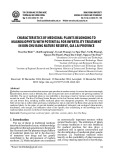
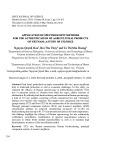
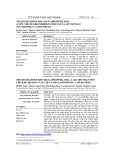
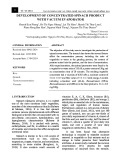
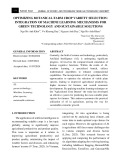
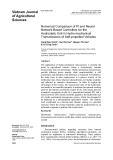
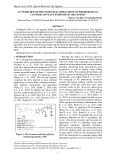
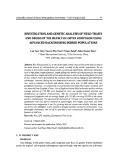

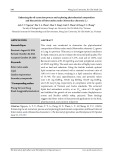
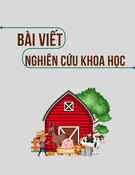
![Bài giảng Bệnh lý học thú y [chuẩn nhất]](https://cdn.tailieu.vn/images/document/thumbnail/2025/20250805/vijiraiya/135x160/40021754390489.jpg)
![Bài giảng Ký sinh trùng và bệnh ký sinh trùng thú y [mới nhất]](https://cdn.tailieu.vn/images/document/thumbnail/2025/20250731/vijiraiya/135x160/93801753957680.jpg)
![Bệnh trên bò: Tài liệu một số bệnh thường gặp [A-Z]](https://cdn.tailieu.vn/images/document/thumbnail/2025/20250726/kimphuong1001/135x160/9451753499042.jpg)






